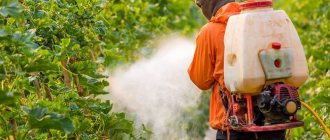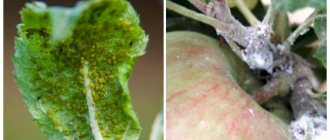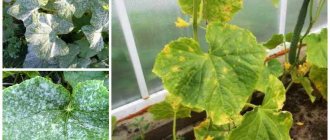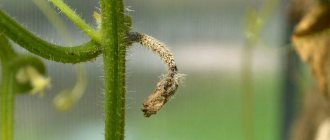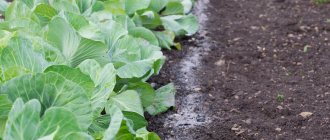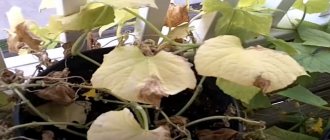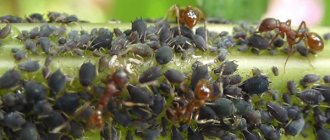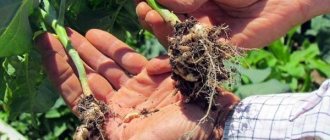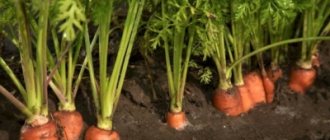Like any garden crops, cucumbers are susceptible to a number of different diseases, the treatment of which requires the use of special chemicals. This method is best suited for agricultural complexes, however, in garden conditions, treating cucumbers against diseases with folk remedies is the most effective.
It should be noted that it is easier to prevent any disease than to fight it, so preventative treatment of cucumber plants is of particular importance when caring for seedlings, and it will significantly save your money and effort.
As practice shows, the main period when cucumbers are exposed to various diseases is during flowering, which means that preventive treatment of the plant is best carried out at the development stage (when the first flowers appear).
Preventive treatment of cucumbers
For preventive purposes, it is customary to use the following for spraying leaves of cucumber plants:
- Milk mixture with the addition of 30 drops of iodine and three tablespoons of grated laundry soap. It is recommended to use this solution once every ten days throughout the entire period of fetal ripening. This is an effective, universal mixture with which experienced gardeners treat beneficial plants, in particular cucumbers.
- To treat and protect cucumbers from fungal diseases, an ash solution is used, which also serves as foliar feeding for the plant. To make an ash solution, you need to pour two liters of boiling water over sifted wood ash and add a little grated laundry soap. For preventive purposes, the mixture is used once a week, and when the first signs of fungal diseases appear, plants should be sprayed 2-3 times a week.
- Another excellent remedy for preventing cucumbers from fungal diseases is a solution based on rye bread, 30 milliliters of iodine and water. The solution should be cooled before use.
Tip: regularly spraying cucumbers with this solution will increase the amount of harvest and the speed of fruit ripening.
If preventive measures do not help and mold, fungus, holes or spots appear on the cucumber leaves, then you should proceed to treating the cucumbers with folk remedies or chemicals. An effective remedy is the biological product “Fitosporin”.
Recommendations from experienced gardeners for growing cucumbers:
- If cucumbers at the flowering stage are dominated by small flowers, a light shade of the fruit and thin vines, then the cucumbers do not have enough nitrogen. To prevent this, you should regularly feed the plant with a mullein mixture. To prepare the mixture you will need: 8 liters of water and one liter of mullein.
- If the shape of the cucumbers is more rounded, and the body narrows near the stalk, then the fruits do not have enough potassium. Potassium deficiency can be compensated for by daily use of wood ash diluted in water (one liter of solution per cucumber bush).
- After all the cucumbers have been collected, it is necessary to clear the beds of weeds and roots (disinfect the beds using a solution of copper sulfate). Such prevention will protect your crop from fungal and other diseases for several years to come.
Answers to frequently asked questions
When growing cucumbers and encountering the first signs of disease, the gardener may have questions that require a quick solution. The main ones:
What are the signs to sound the alarm?
It is recommended to take measures against diseases immediately in the event of unexpected wilting of leaves, the appearance of various spots, or rotting of fruits and stems.
When should pesticides be used?
If the disease has passed the early stage, then treatment with pesticides is inevitable.
Do I need to remove infected parts of the plant?
Affected leaves and fruits must be torn off and burned.
Is it possible to treat healthy plants with folk remedies?
Applying safe products is beneficial for any plant. They strengthen immunity to disease and have a beneficial effect on development and fruiting.
Treatment of cucumbers with folk remedies
When planting cucumbers, you should pay special attention to the condition of the ground rocks, soil moisture, as well as day and night temperatures. If at least one of the above criteria is violated, holes, spots and other signs of serious diseases may appear on the leaves of cucumbers. To combat cucumber diseases, two methods are used: chemical and household (using folk remedies).
The low cost of production and high efficiency of use persuade experienced gardeners to use traditional, folk methods of combating plant ailments. Some homemade solutions compare favorably with store-bought drugs. For each disease, several effective homemade tips have been developed. Let's look at them in more detail.
See also
The best varieties of cucumbers for the northwest: Altai, Miranda, Cascade, Restina and Altai earlyRead
Diseases of cucumbers, how to treat plants
Diseases of cucumbers are viral and fungal.
Fungal diseases are spread by fungi that infect cucumbers. If you don’t start fighting them in time, the plant may die. Fungal diseases include:
- Powdery mildew is a very common disease among cucumbers. It looks like a whitish coating on the leaves. When it appears, it is easily erased, but if the plant is not treated, the coating becomes rusty in color, thickens and fills the entire leaf. As a result, it dries out and falls off.
This could cause the entire plant to die. Most often, the disease spreads in a greenhouse, less often on the ground. Against this disease, cucumbers can be treated with the chemicals Homecin and Arceride. First, the dried leaves are torn off, and the infected areas are sprayed with the product every two weeks. If the fungus has become accustomed to the product used, then you need to change the drug. - Root rot is a disease caused by pathogenic fungi that remain in the soil or on seeds that have not been disinfected. In addition to the already existing fungus in the soil, it can be introduced during planting. Abundant watering and fertilizing promote the development of this fungus. Find out how to properly feed cucumbers so as not to harm them.
Detecting the disease is not easy, because as the name suggests, it affects the roots of the plant.At the beginning of the disease, the root collar acquires a yellow tint, which changes to brown over time. Then the lower leaves wither, the plant below begins to dry out, and at the same time is easily removed from the soil. Brown, soft areas appear on the roots.
Methods for treating cucumbers from root rot include agricultural practices
To help the plant cope with the disease, carefully sprinkle the bushes 5 cm with new soil. This will allow them to grow new roots and resume feeding. Spray the soil with Trichodermin or Baktofit. But if the plant is severely damaged, it should be dug up and burned. This disease cannot be cured in its later stages. To prevent such a disease from occurring in the future, the soil and seeds should be disinfected in advance.
- Anthracnose is one of the most dangerous diseases of cucumbers. Activated at high humidity. First, yellow spots appear on the leaves, then they begin to dry and tears form in their place. The disease affects not only the leaves and stems, but also the fruits. Elongated brown depressions and ulcers appear on them, then the fruits begin to rot.
Methods for treating cucumbers from Anthracnose include the use of fungicides such as Quadris, Fundazol and Strobi. - Cladosporiosis - most often spreads on greenhouse plants. Rusty spots appear on the leaves, and the fruits are covered with dark spots that quickly grow and join together.
This disease is treated with Fundazol and Oxyx or 1% Bordeaux mixture. Heavily infested plants should be dug up and burned. To prevent this disease, try to remove all remnants of roots and plants from the ground when digging, alternate plantings, disinfect the soil before planting plants in the ground, and water the cucumbers with warm water. Most often, this fungus becomes active at the end of the season, when the difference between day and night temperatures is high. - Downy mildew is also called downy mildew. It appears on the leaves as yellowish spots, then they grow and the leaf dries out. If the disease is not stopped in time, it can ruin half the harvest.
To combat it, the drugs Trichoderma, Acrobat MC or Gamair are used. The soil is covered with ash. For prevention, cucumber bushes are sprayed with Fitosporin. - White rot manifests itself as a white coating, similar to fluff, first on the stems and leaves of cucumbers, and then spreads to the fruits. As a result, they soften and rot.
If you form a cucumber bush correctly, then other methods of treating cucumbers for White rot will not be needed
It has been noticed that white rot appears on frequently planted plants that are in close contact with each other. To avoid this, thin them out and do not allow the plantings to thicken. The article will help you with this - Forming cucumbers, how to properly form a plant. You can fight the disease with the help of Bordeaux mixture and nitrogen fertilizers. Infected areas should be removed and the cut should be sprinkled with coal.
- Gray rot, like white rot, appears in thickened plantings. It appears as a gray coating on the leaves, stems and fruits. Very quickly such ovaries become slimy and fall off. The causes of the disease are the same as for white rot. These include dense plantings, watering with cold water and high humidity in the greenhouse.
To prevent this disease, treat the plants - remove damaged leaves, treat the cuts with charcoal. Spray them with fungicides. Heavily infected plants should be uprooted and burned. The spores of the fungus that causes this disease can live in the ground for more than one season. Therefore, before the new season, treat the greenhouse, disinfect the seeds and soil before planting cucumbers. - Fusarium is a dangerous fungal disease. It begins its action from the root system, so it cannot always be detected in time. Symptoms of fusarium can include wilting flowers, the cut of the stem becomes brown, and the root collar also becomes brown. Gradually, the diseased plant withers and loses its ovaries.
Traditional methods of combating this disease are good only in the early stages of the disease. And then it’s better to use chemicals like Quadris. Diseased plants are sprayed with it. And those that are heavily infected are torn out and burned. To avoid this disease, you should soak the seeds in a solution of Fitosporin, disinfect the soil in the greenhouse and disinfect the greenhouse itself.
We have listed the most famous cucumber fungal diseases. Now let's move on to viral ones. The most common viral diseases of cucumbers are varieties of mosaics.
Cucumber mosaic - includes several varieties.
This:
- ordinary mosaic;
- white-green speckled;
- field
All of them are activated when the temperature increases to 30 degrees or sudden changes in day and night temperatures.
- The usual mosaic appears as yellow spots on the leaves, then they curl and dry out. The stem cracks and the plant does not produce ovaries.
- A speckled mosaic turns the leaf veins light green and the leaf becomes wavy. Cucumbers stop growing, the ovaries become deformed, the fruits acquire a bitter taste and a white coating on the peel.
- With field mosaic, the leaves of the plant wither and fall off. Such a plant can be sprayed with Fitosporin.
For other types, to stop the disease, the ground is sprinkled with ash and watered with a weak solution of potassium permanganate. Heavily infested plants should be dug up and burned. Viral diseases are almost impossible to cure. Therefore, gardeners try to cultivate the soil and seeds in such a way as to prevent them. Weed weeds, since it is from them that carriers of viral viruses enter the plants.
Downy mildew on cucumber leaves
The main symptom of this disease is the appearance of small white spots along the edges of the leaves of the plant (outwardly the spots resemble flour, photos of leaves susceptible to the disease indicate this).
In addition, cucumber leaves may change their color to a reddish-brown hue and dry out at the edges. The consequence of powdery mildew may be the cessation of fruiting of cucumbers.
Homemade preparations for the treatment of downy mildew:
- Serum based on copper sulfate. To prepare it you need 7 liters of water and several tablespoons of vitriol. The two substances are mixed evenly and the bushes of the plant are sprayed up to twice a week.
- Garlic tincture. Take 30 grams of crushed garlic, pour it with a liter of boiled water and leave the tincture in a dark, cold room. After preparing the infusion, dilute it with 9 liters of water. At the first signs of the appearance of downy mildew, it is necessary to spray the infected areas with this solution.
- Cucumber fruits should be sprayed with a solution of potassium permanganate. This is probably the most famous and effective remedy for protecting against downy mildew. Dilute 2 grams of potassium permanganate in ten liters of water.
What to spray for ovaries
In order for cucumbers to form multiple ovaries and have less empty color, it is necessary to use special preparations that help plants in this matter. Most often, summer residents and gardeners use preparations such as Epin or Zircon.
These products are known as effective plant protectors; in addition, they significantly increase the resistance of cucumbers to the external environment, and also increase their immunity and help resist pests and diseases.
These products must be used according to the instructions included with the package. It is categorically undesirable to deviate in one direction or the other.
The video shows the spraying process:
In addition, a product such as boric acid helps to increase the number of ovaries of bunched varieties of cucumbers. This cheap, accessible drug increases crop productivity, stimulates the germination of planting material, and also nourishes plant roots.
Review of sprayers and folk remedies
Let's conduct a short review of the most popular garden sprayers and find out in what cases they can be useful for cucumbers.
Boric acid
As mentioned above, boric acid is an excellent tool for the formation of cucumber ovaries.
The drug can be useful as a means to increase plant resistance to diseases and pests, and strengthens the immunity of cucumbers.
Keep in mind that if this substance is used together with other trace elements or additives, the amount of acid in the total solution must be significantly reduced (to 0.05%). Otherwise, the concentration of the substance will be too strong and may burn the roots of the cucumbers. But how boric acid is used against aphids on apple trees is described in detail in this material.
Is it possible to spray a cucumber with milk with iodine?
This remedy is recommended to be used when the plant has just sprouted and its first 3-4 leaves have formed. Spraying milk with iodine is a preventive measure against pests and diseases.
The composition is prepared as follows: a bucket of water, 30 drops of iodine, one liter of milk, 20-30 grams of laundry soap (grated, preferably). Spraying with this composition is recommended once every ten days.
Serum
This product is used to keep cucumber tops green for a long time. In addition, whey spraying can increase productivity by forming ovaries. To prepare the whey, you need to soak a loaf of bread in a bucket of water, after kneading it, and pour the contents of one bottle of iodine into the bucket. To infuse, the solution must be left overnight.
In the morning it is filtered and bottled (glass only!). In a cool place, the whey can be stored all season. Cucumbers are sprayed with the resulting mixture once every couple of weeks. You need to take a liter of whey concentrate per bucket of water. It will also be useful to learn about how anti-phytophthora serum is used on tomatoes.
Urea
This substance can be used as a fertilizer rich in nitrogen, as well as a preventive and therapeutic agent. Urea can protect cucumbers from powdery mildew and anthractosis: in this case, the substance is used together with mullein.
In the video - urea for cucumbers:
Soda
Simple baking soda, which can be found in any household, can protect cucumbers from such a dangerous disease as gray rot. This disease manifests itself in the form of gray spots on the leaves, which gradually spread along the shoots and stems.
If measures are not taken, gray rot can completely destroy all the plants in the garden.
To prepare a soda solution, you need to take 75 grams of dry matter in a bucket of water. The liquid is mixed and then the cucumber bushes are sprayed with it. The frequency of spraying with this composition is once every 3 days.
Trichopolum
This substance can cope with cucumber bacteriosis, a common and contagious disease. If cucumbers become ill with bacteriosis during the flowering period, then this fact may prevent any fruit from setting at all.
Trichopolum is able to prevent the development of not only late blight, but also other fungal diseases on cucumbers and tomatoes.
To prepare a solution for spraying, two crushed tablets of the drug are mixed with a liter of water. And if you want to water the bushes with a healing solution, then dissolve 5 tablets of the drug in a bucket of water. To use Trichopolum as a preventative against bacteriosis, before planting cucumbers, it is recommended to bury a tablet of the product in each hole.
Zelenka
The familiar green liquid with alcohol helps protect cucumbers from diseases such as downy mildew. In addition to destroying the spores of this most dangerous disease, brilliant green also nourishes the soil, making it more fertile.
To prepare the composition, you need to dissolve urea (50 g), whey (2 l), and brilliant green (10 ml) in a bucket of water (10 l). All components must be thoroughly mixed, and then the solution must be used to spray cucumber bushes.
Ammonia
This remedy, also known as ammonia, is used if the cucumber leaves begin to turn yellow or are too small. In addition, ammonia can also help with a complete stop in the growth of the bush, as well as in the absence of flowering. The substance accelerates all processes in the plant, activates its vitality.
Ammonia (50 g) is dissolved in a bucket of water with liquid soap. Then the resulting composition is sprayed on cucumber bushes for the problems listed above.
Peroxide
This product, sold in pharmacies at an affordable price, can also be used to prevent cucumber diseases. To prepare the composition, you need to stir a 3% peroxide solution in water. Proportion: 20 ml of peroxide per liter of water.
Prepare immediately the volume of solution required for one spraying; storing it is not recommended.
We examined the features of combating cucumber diseases and pests. As you can see, there are many ways to deal with these annoying problems that prevent you from getting a rich harvest. Modern fungicides, insecticides, as well as various folk and home methods will help you defeat any disease that affects cucumbers, as well as stop the attack of harmful insects. Maybe
Powdery mildew and its treatment
Externally, true powdery mildew differs from downy mildew only in the distribution of the white coating. The white coating gradually spreads to the entire leaf surface and fills the underside of the leaf, after which the leaves acquire a yellow tint and become drier and more fragile.
Homemade preparations for the treatment of powdery mildew:
- Use whey in a ratio of one to ten liters of water. After treating a plant leaf with this serum, a thin film is formed on it, which prevents the fungal disease from spreading.
- To treat powdery mildew, decoctions of nettle, wormwood or tansy are also used.
- A universal folk remedy for combating fungal diseases is mullein solution. To prepare it you need to: dilute one liter of mullein with three liters of water and let it brew for three days. Before spraying the plants, the prepared solution should be diluted in three liters of water.
- Ash solution is used to prevent the growth of fungal bacteria, as well as to treat powdery mildew on cucumber leaves. The recipe for preparing an ash solution is quite simple: pour one glass of ash with two liters of water and leave to infuse for 2-3 days. Leaves should be treated with the solution at least twice a week, after filtering the solution and adding 4 grams of laundry soap to it.
Application of boric acid
Cucumbers are especially sensitive to insufficient boron content in the soil. Most often observed in dry weather. The lack of an element can be determined by the main signs:
- developmental delay;
- very weak flowering;
- small number of ovaries;
- fresh foliage becomes very dense;
- leaves curl down;
- presence of cork stains on vegetables;
- A sufficiently severe deficiency is accompanied by the falling of flowers and ovaries, while the root system becomes orange.
The lack of the required amount of boron reduces the plant’s resistance to fungal diseases, such as dry or brown rot, bacteriosis. If characteristic symptoms are detected, the cucumbers should be sprayed with boric acid. This treatment promotes better development of the root system, increases the number of peduncles and ovaries, and accordingly the amount of harvest will increase. Foliar feeding improves the process of photosynthesis, which has a positive effect on foliage health. An important factor is the increase in sugar levels in the fruit, which improves the taste of cucumbers. Boric acid allows strong shoots and quality vegetables to grow.
Note! An excess of boron is not allowed, as the element leads to leaf burns. It is recommended to apply only to peat or turf-podzolic soil. It is in it that this substance is lacking. Chernozem is rich in the element and does not require additional application.
To prepare the solution, you must follow the rules for diluting it. Boron powder is added to hot water, and then cold water is poured in. It is necessary to adhere to standard proportions: 5 g of boron is dissolved in 2 liters of hot water, then diluted with cold water to a volume of 10 liters. It is allowed to add sugar (no more than 100 g) to the solution. This will attract more pollinating insects.
Treatment of white rot
White rot is one of the most serious infectious diseases, dangerous for most garden plants, including cucumbers. A distinctive feature of this disease is the appearance of a white coating.
If damaged areas of the plant are treated incorrectly, it may begin to darken and subsequently die. White rot spreads not only to the leaves of cucumbers, but also to the fruits and stems of the plant.
This pathology occurs on cucumbers as a result of incorrect temperature conditions in a greenhouse or greenhouse. Insufficient air circulation in the greenhouse or closely planted plant beds can lead to the accelerated spread of white rot. The danger of this disease lies in its latent form.
The main method of combating white rot is timely disinfection of soil or greenhouse, as well as the use of a special mixture of 2 grams of copper sulfate, 10 liters of water and 10 grams of urea. Important: before using the mixture to spray the affected areas of the plant, it must be shaken.
Soil treatment before sowing seeds
Caring for cucumbers begins even before planting - with cultivating the soil at the site of future beds. The purpose of these actions is to prevent damage to seedlings and seedlings by root and basal rot. The soil may contain pathogens of fungal and bacterial infections that remained there from previous “owners” or got into the garden bed or greenhouse along with organic fertilizers. They weaken the root system of young plants and often lead to their death.
To treat the soil, use bacterial fungicides Gamair and Alirin-B. 1-3 days before sowing the seeds, dilute 2 tablets in 10 liters of water and thoroughly water the soil in the open garden bed and in the greenhouse.
Diseases of cucumbers often develop due to improper sowing. For example, cucumber seeds were sown in unheated or overly wet soil. Planting seeds too deeply into the soil also negatively affects the immunity of the crop.
Olive spot
Externally, this disease is represented by a large number of small damage to the leaves of the plant (spots and ulcers). The spots are often olive in color.
The main reason for the occurrence of olive spot is insufficient care for flowering cucumbers. The spread of the pathological process is caused by heavy rainfall and wind.
It is necessary to treat olive spot with a special solution based on liquid laundry soap and copper sulfate. To prepare the medicine, take 10 liters of water, 40 grams of laundry soap and 40 grams of copper sulfate.
See also
Description of the cucumber variety Moscow Evenings, features of cultivation and careRead
How to deal with insect pests
To control cucumber pests, both chemicals and folk remedies are used. In this case, they must take into account which insect has settled on the plant.
Fungicides and insecticides
Fungicides for treating cucumbers are used if pests have infected the vegetables with fungal diseases. The most effective drugs include the following:
- Previkur energy. Eliminates powdery mildew, stimulates flowering, strengthens roots. The product is used for drip irrigation, spraying cucumber stems and leaves, and watering at the root.
- Strobe. Helps heal plants and protects them from re-infection. Cucumbers are sprayed with Strobi solution every 2 weeks. The product begins to act 2 hours after application. It helps cure peronosporosis.
- Bordeaux mixture. Copper sulfate, which is part of it, destroys fungal spores, and lime effectively neutralizes acid. To treat cucumbers, use a 1% solution of the product.
- Home. The drug is intended for the treatment of cucumbers in a greenhouse. The product does not penetrate inside the leaf plates. It is recommended to combine Khom with other substances intended to protect plants.
Insecticides help control insect pests. They are divided into drugs of systemic and contact action. The most effective are the following:
- Avant. This is an insecticide that has a contact-intestinal effect. Fights codling moths and leaf rollers, destroying their larvae at all stages of development. Pests die within 1-3 days. This preparation is contact, so it is used to treat leaf plates evenly on both sides.
- Agravertine. An enteric-contact insectoacaricide designed to control cucumber pests in greenhouses and open ground. Destroys spider mites, moths, aphids, moths, leaf rollers. It negatively affects the nervous system of pests, causing their paralysis and death. Maximum effectiveness is observed on days 4-5.
- Admiral. Hormonal insecticide of contact-intestinal action. Helps get rid of whiteflies, scale insects and other insects with piercing-sucking mouthparts. The drug disrupts the growth and development of insects. After one treatment, the pest population is greatly reduced. To destroy all parasites, it is enough to treat the cucumbers 1-2 times.
- Aktara. An insecticide with a wide spectrum of effects. You can use it to spray the bush and apply it to the soil. With its help, it will be possible to destroy aphids, whiteflies, and scale insects. The death of pests occurs one day after treating the bushes.
- Tanrek. Insecticide of systemic and contact action. Has a detrimental effect on the nervous system of insects. The drug is capable of destroying larvae and adults. The product penetrates into plants through roots, stems and leaves. Pests, feeding on poisonous tissues of the crop, lose motor activity and the ability to eat food and die within a day.
Tanrek destroys larvae and adults.
Folk remedies
There are many effective folk remedies with which cucumbers can be rid of pests.
Wood ash
For this purpose, wood ash is often used, which kills insects and harmful microorganisms. For prevention, it is recommended to sprinkle the leaf plates with a small amount of ash solution. Slugs are well repelled by treating the soil with the same substance.
Garlic infusion
Garlic infusion works well against pests. To prepare it, put crushed garlic cloves in a 1 liter jar, add 40 ml of liquid soap and 500 ml of vegetable oil. Infuse the product for a day, then filter. To spray cucumbers, 30 ml of solution is diluted with 0.5 liters of water.
Hot pepper against spider mites
The following remedy helps get rid of spider mites. Finely chop 50 g of hot pepper, place it in a saucepan with water (0.5 l) and simmer on the fire for 1 hour. To process cucumbers, the cooled mixture is diluted with water in a ratio of 1:3. You can also mix 4 liters of water and 50 ml of 3% perhydrol. Treat the bushes three times a day.
Mustard powder against aphids
To destroy aphids and other pests on cucumbers, use mustard powder. To prepare a solution, 100 g of the substance is diluted with 4 liters of boiling water and left for 4-5 hours, stirring regularly. After the mustard has settled, the clear liquid is poured into a 10 liter sprayer, add 4 tbsp. l. vegetable oil and 6 tbsp. l. crushed laundry soap. The resulting product is used to treat the bushes.
Mustard powder is great for controlling aphids on cucumbers.
Root rot
Experts say the reason for the spread of root rot is frequent watering of the plant with cold water, as well as high humidity in the greenhouse and high soil temperature. Signs of the disease are small cracks, which can be easily eliminated using a product with the following composition: 60 grams of wood ash. 5 grams of copper sulfate, 0.5 liters of water. At an advanced stage of the disease, cracks must be treated with ash, activated carbon or dry chalk.
Folk remedies for cucumber diseases:
- Iodine solution. Mix water and iodine in a 1:2 ratio and treat the stems of the plant with the resulting mixture. Every 3-4 days, the stems and leaves of cucumber plants should be treated with this preparation.
- Milk mixture with iodine. To make this product you need to: mix 1 liter of milk, 30 drops of iodine, 10 liters of water and 15-20 grams of chopped laundry soap. It is recommended to use this solution no more than once every 10 days (until the development of root rot stops).
Cucumber varieties resistant to diseases
Breeders have developed many varieties of cucumbers that are highly resistant to common cucumber diseases. Knowing this will help gardeners choose the most optimal variety to grow on their site.
Did you know? Among the varieties of cucumbers, there is one type of fruit with an unusual appearance, called the “crystal apple” because of the round appearance of the vegetable and the bright yellow color of the pulp and peel. They taste like ordinary cucumbers.
Among them:
- Thumb Boy. Hybrid super-early ripening variety (the first fruits appear on the 37th day from the first shoots). The bushes are branched, with abundant fruiting. The fruits are tuberculate, bright green, white-thorned, up to 11 cm long and weighing up to 65 g.
- Masha. Ultra-early high-yielding hybrid with fruits appearing on the 37th day after germination. Has a long fruiting period. The fruits are large-tubercular, cylindrical, there is no bitterness.
- Martin. The variety is early ripening, the fruits are harvested already on the 41st day from sowing. Cucumbers are from 9 to 14 cm long, with a matte surface, oval-cylindrical, dark green, have blurred stripes and large, sparsely spaced tubercles.
- Natalie. The variety is mid-early (fruiting on the 48th day). Cucumbers are short, cylindrical, green, with tubercles and light stripes; up to 13 cm long, not bitter in taste.
- Phoenix plus. The variety is mid-season, bears fruit already on the 45th day and right up to the first light frost. The fruits are oval and tuberculate, dark green, with blurred stripes, up to 12 cm long. Cucumbers with juicy, crisp and not bitter pulp.
- Sir. Mid-early cucumbers (47th day). The fruits are short (up to 14 cm), with large tubercles, cylindrical, bright green, with longitudinal stripes and brown spines; not bitter.
- Benefit. Hybrid early ripening variety (45 days). The fruits are 120 g each, up to 12 cm long, dark green, with small tubercles and white spines. The taste is sweet, with a crunch, not bitter.
- Baby crane. Hybrid mid-early variety (48 days). The greens are oval-cylindrical, with large tubercles, up to 12 cm long, weighing up to 90 g. The fruits have a thin peel and tender, dense, crispy flesh.
- Fontana. The hybrid is mid-season (up to 55 days). Cylindrical fruits with a tuberculate surface and black spines. The taste is not bitter, crispy. The weight of the fruit is on average 100 g, length - up to 12 cm.
- Darling. Mid-season hybrid (55 days) with large, tuberculate, spindle-shaped greens. The fruits are up to 12 cm long and weigh up to 90 g, with excellent taste.
All the folk remedies described above for cucumber problems are effective, affordable and do not require significant material investments. If they are used correctly and on time, adhering to the indicated dosages, then the aggravation of all possible difficulties that arise during the agricultural technology of this garden crop can be avoided.
Infectious disease spider mite and its treatment
The spider mite has a significantly small size (its length can reach only 1-2 millimeters). The tick has a specific color (it can be brown, yellow or green). At the initial stages of the disease, it is almost impossible to detect a tick.
The spider mite is located on the back side of the plant leaf, sucks the juice of the cucumber, thereby leaving round holes on the leaves.
To combat spider mites use:
- Garlic infusion. Chop 50 grams of garlic, add 0.5 liters of water to the mixture, let the broth brew, then filter the infusion and place with the same amount of water. Spraying water must be done in the evening at least twice a week.
- Pepper based solution. Cut the hot pepper into small pieces, add a little water and send the mixture to simmer on the fire for 50-60 minutes. Place the finished mixture with water in a ratio of 1:3.
- To combat spider mites, a solution of perhydrol is also suitable (60 milliliters of 3% substance per 3 liters of water).
- Dry tobacco will also be an excellent preventative against spider mites. It should be sprayed onto the dampened leaves of the plant.
If the leaves turn yellow
Let's figure out how to process cucumbers if their leaves begin to turn yellow.
Firstly, you need to understand first what caused the yellowing of the foliage. As a rule, the causes of this problem are most often temperature changes, and sometimes a lack of potassium. Having established the cause, you can stop it by covering the plants at night so that they do not freeze, and if we are talking about greenhouse cultivation, then install winter heating in a polycarbonate greenhouse. If everything is normal with the temperature, then it is necessary to feed the plants with potassium.
In the video, the leaves on the cucumbers are turning yellow:
In addition, you can stop yellowing by spraying with a solution of wood ash. This measure is known to all experienced gardeners, has been used for a long time, and shows good results.
melon aphid
The greatest danger to cucumbers is the melon aphid. This small green or black insect can cause the plant to rot in the shortest possible time.
The main remedy for combating aphids is an infusion of wood ash, laundry soap and water. The solution should be left to infuse for 24 hours, then mixed thoroughly and applied to the damaged areas of the plant using a sponge. In addition, this solution can be used to moisten soil rocks.
Requirements for processing solutions
At a summer cottage, both industrial and folk remedies can be used for processing cucumbers. However, all compositions must meet a number of requirements:
- Safety for humans.
- The benefit to the plant must outweigh the harm (some insecticides are toxic to the crop itself and humans).
- High degree of adhesion or absorption of the active solution.
- Minimum inhibitory concentration for antibacterial drugs, which allows reducing the frequency of treatment.
Treatment solutions should not accumulate in fruits (excess chemicals can lead to food poisoning in humans).
Conclusion
Diseases of cucumbers and their treatment are not particularly difficult, so it is quite possible to get rid of infectious diseases with the help of simple folk remedies. The answer to the question: “how to treat cucumbers against diseases with folk remedies” you now know. However, it is worth noting that the effectiveness of the drugs depends on the degree of infection of the plant, and often the solution can only be preventive and not therapeutic. In case of significant infestations of cucumbers, it is worth using chemicals.
Effective preparations for cucumbers against diseases and pests
A brief description of the signs of the main diseases of cucumbers and the drugs that are best used to treat them are presented in the table.
| Disease | Manifestations | Purchased funds | Folk remedies |
| Powdery mildew | Whitish coating on leaves | Byleton; Topaz; Strobe; Gamair; Albite; Alirin-B; Thiovit Jet; | Ash solutions; Manganese; Tobacco dust; Milk serum; Garlic infusions; Mustard; Iodine; Onion peel |
| Downy mildew (downy mildew) | light yellow small spots on the leaves | HOM; Abiga Peak; Ordan; Quadris; Consento; Previkur | |
| Cladosporiosis (brown olive spot) | Olive spots on leaves and stems | Abiga-pik"; Carticide; Bordeaux mixture | |
| fusarium | Wilting of the plant starting from the top | Trichophyte; Trichodermin; Glyocladin; Baktofit; Fitosporin-M; Vitaros.; Fundazol; Arbothrin; Fundazim; Agrocyte; Benomyl | |
| Gray rot | gray coating on the fruits, over time replaced by fluff | Alirin B; Gamair; Abiga Peak; HOM; Ordan; Bordeaux mixture; Planriz | |
| White rot | slippery coating | ||
| Root rot | The roots turn brown and dry out | ||
| Field mosaic | Yellow-green spots on leaves | Aktelik; Aktara | |
| Speckled mosaic | Whitish or yellowish “blots” |
When and how to spray cucumbers
Treatment of plants for both preventive and medicinal purposes should be done in dry, windless weather in the evening, when the sun is already setting and will not cause severe burns. But don’t delay processing: you need to do it before the dew falls!
Since most products are in the form of solutions, you need to know how to spray cucumbers correctly. It is very important that the solution is not cold, but not hot either. Cucumber is a delicate plant, native to the tropics, so it absolutely does not like cold showers! Spraying the liquid product should be done evenly, preferably so that it does not flow down, but remains on the leaves.
Causes and signs of plant disease
Vegetable crops are susceptible to diseases for various reasons. Most often, infection occurs due to unfavorable environmental conditions. In particular, the following factors lead to the occurrence of infections:
- accumulation of a large amount of plant residues in the soil;
- constant cloudy climate and low ambient temperature;
- oversaturation of the soil with nitrogenous fertilizer;
- moistening the soil with cold water;
- disregard for crop rotation rules.
The spread of diseases can be detected by visual signs. In infected plantings, the foliage changes color and curls, the ground part rots, inflorescences and ovaries do not form, and the fruits do not grow to the expected size.
